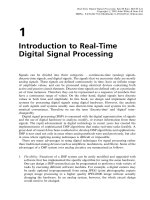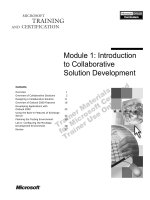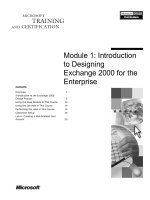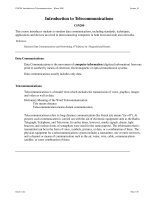Week 1 - Introduction to grammar ppt
Bạn đang xem bản rút gọn của tài liệu. Xem và tải ngay bản đầy đủ của tài liệu tại đây (251.67 KB, 15 trang )
INTRODUCTION TO
GRAMMAR
Nguyễn Hồng Diệu
HULIS - VNU
Course outline
•
Subject: Grammar
•
Number of credits: 3
•
Duration: 15 weeks
•
Course books
–
Quirk & Greenbaum (1973) A university
grammar of English
–
Close (1974) A university grammar of English -
Workbook
Course outline
•
Objective
–
to develop an understanding of the
fundamentals of English grammar
•
Prerequisite
–
good command of English
•
Main areas
–
Morphology
–
Syntax
Course outline
•
Course content
–
Word formation
–
Sentence elements
–
Parts of speech
–
Phrases
–
Clauses
–
Sentences
Course outline
•
Class activities
–
Lectures
–
Discussion of readings
–
Presentations
–
In-class tutorials
•
Self study
–
Review of the theory
–
Practice exercises (Workbook)
–
Tutorial exercises
Course outline
•
Assessment
–
Mini tests + Participation: 10%
–
Mid-term test: 30%
–
Final test: 60%
•
Ground rules
–
No coming late
–
No phone ringing in class
–
No text message & late call to teacher
–
All deadlines must be met
–
Pay due respect to the speaker
Grammar and Linguistics
LINGUISTICS
Grammar
Phonology
Semantics
Discourse Analysis
Grammar and Linguistics
1. Phonology
–
Subject: Phonemes
(the smallest linguistic units)
–
Subclasses:
•
Segmental
–
Vowels
–
Consonants
•
Supra segmental
–
Stress rhythm
–
Intonation
Grammar and Linguistics
2. Grammar
–
Subject: Morphemes
(the smallest meaningful linguistic units)
–
Types of morphemes:
•
Words (parts of speech)
•
Phrases (NP, VP, etc.)
•
Clauses (independent & dependent)
•
Sentences (simple, compound and complex)
Grammar and Linguistics
3. Semantics
Concerned with:
•
The meanings of words
•
Utterances (phrases, clauses and sentences)
3. Discourse analysis
Concerned with:
•
Larger units than sentences
•
Means of linking sentences (cohesion & coherence)
•
The relational factors: context
Grammar as a set of rules
•
Grammar must be explicitly taught
•
Grammar is absolute and fixed
•
Grammar is inherently difficult and
confusing, only apparent to language
teachers or linguists
Look at the s entences below and decide whether it
is G (grammatical), N (ungrammatical) or ? (not
s ure)
•
___ She had less problems with the move to
a new school than she thought she would.
•
___ She lays in bed all day whenever she
gets a migraine headache.
•
___ My sister Alice, who is older than me,
still lives at home.
•
___ Everyone needs to buy their books
before the first day of class.
Language and change
•
How people express themselves vs. How
language experts say they should
•
There is no uniform agreement among
experts as to what is “correct” or acceptable
•
The nature of language: a living, fluid entity
that changes in response to changes in
society (Sentence 4)
Language is rule-governed
•
Grammar guides speakers in how to string
together symbols, sounds, and words to make
coherent, meaningful sentences
•
Grammar knowledge is intuitive and reflects the
innate ability of speakers
•
One can use and adapt new/unique elements
according to the patterns of the language
Example:
Beware the J abberwock, my son!
The jaws that bite, the claws that catch!
Beware the J ubjub bird, and shun
The frumious Bandersnatch!
(Jabberwocky by Lewis Carroll)
Us ing the pre vio us analys is to draw c onclus ions
about the italic ized words
And, as in uffish thought he stood,
The Jabberwock, with eyes on flame,
Came whiffling through the tulgey wood,
And burbled as it came!
One two! One two! And through and through
The vorpal blade went snicker-snack!
(Carroll, L. (1871) Through the looking glass and what Alice found there)









